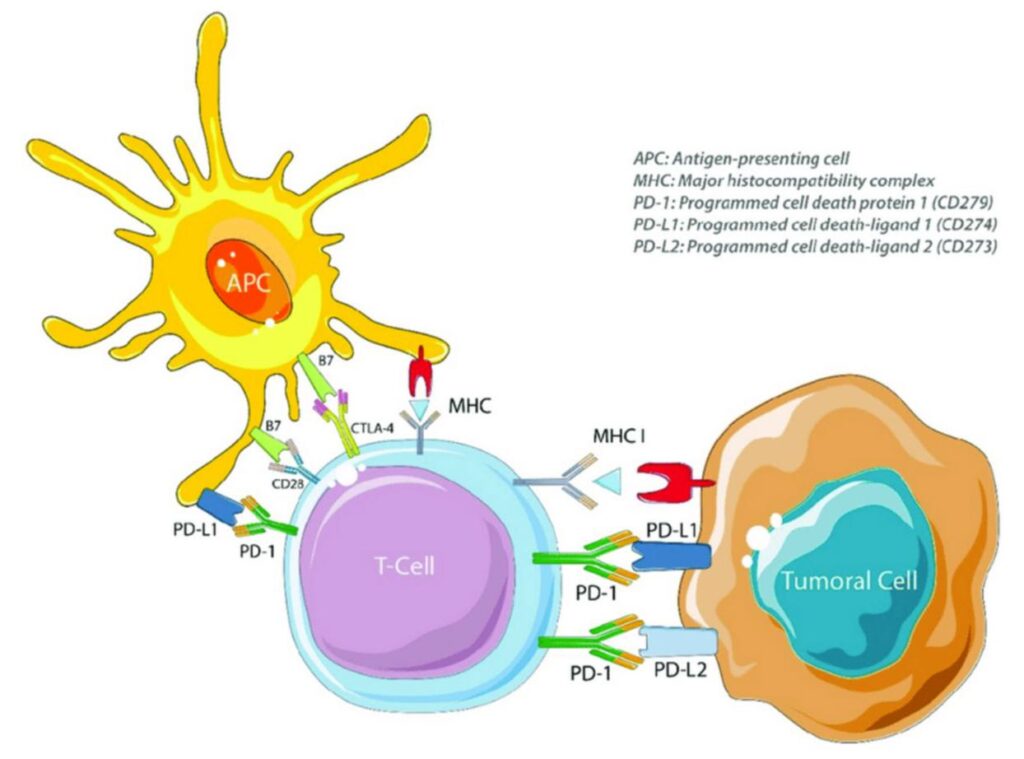Our body has an army of immune cells, like T cells, that fight against threats such as cancer. Normally, T cells see tumor cells as enemies and try to destroy them. But cancer is clever. It finds ways to hijack our own systems to protect itself.
One of cancer’s smartest tricks is turning off T cells. How? By using a special protein called PD-L1. This protein on cancer cells binds to another protein called PD-1 on T cells. Think of it like a handshake. When this handshake happens, the cancer cell sends a message to the T cell: “Don’t kill me.” The T cell listens and becomes silent, letting the cancer grow.
When scientists discovered this trick, they developed drugs called PD-1 and PD-L1 inhibitors. These drugs block the handshake, so T cells can see cancer as the enemy and attack it. This breakthrough, called immune checkpoint therapy, completely changed cancer treatment and even earned the 2018 Nobel Prize in Physiology or Medicine.
But here’s the challenge: not all patients respond to PD-1 therapy. Why does the immune system still fail, even when this handshake is blocked?
A new study (2025) published in Nature (https://doi.org/10.1038/s41586-025-09370-8) has found another clever trick that cancer uses: nerve damage. Some cancers injure nearby nerves by stripping away their protective layer (myelin). This nerve injury causes inflammation, which attracts immune-suppressing cells. These cells silence the immune response in the tumor environment—allowing cancer to survive. As a result, PD-1 inhibitors sometimes fail.
The good news? Scientists discovered that blocking these nerve-driven signals—like IL-6 and interferon pathways—or reducing nerve input to the tumor can restore the immune system’s ability to fight cancer. This opens the door to new combination treatments that could make immunotherapy work better for more patients.
.
বিজ্ঞানীরা ধরে ফেললেন ক্যান্সারের আরেকটি চালাকি: ইমিউনোথেরাপিতে নতুন আশার আলো
আমাদের শরীরে রয়েছে এক ধরনের শক্তিশালী প্রতিরক্ষা কোষ যার নাম হচ্ছে টি কোষ বা টি সেল (T-cells)। এরা ক্যান্সারের মতো শত্রুর সঙ্গে লড়াই করে। সাধারণত টি সেল ক্যান্সার সেলকে (cancer cells) শত্রু হিসেবে বিবেচনা করে এবং এদের ধ্বংস করার চেষ্টা করে। কিন্তু ক্যান্সার খুবই চালাক। এরা আমাদের শরীরের নিজস্ব ব্যবস্থা হাইজ্যাক করে নিজেকে বাঁচিয়ে রাখে।
ক্যান্সারের সবচেয়ে চতুর কৌশলগুলোর একটি হলো টি সেলকে চুপ করিয়ে দেওয়া। ক্যান্সার এটা করে একটি প্রোটিন দিয়ে, যার নাম PD-L1। এই প্রোটিন ক্যান্সার সেলে থাকে এবং এটি টি সেলের প্রোটিন PD-1 এর সঙ্গে যুক্ত হয়। এটা অনেকটা হ্যান্ডশেকের মতো। যখন এই “হ্যান্ডশেক” হয়, তখন ক্যান্সার টি সেলকে বলে দেয়: “আমাকে মেরো না।” টি সেলও তখন চুপ হয়ে যায় এবং ক্যান্সারকে মেরে ফেলে না।
বিজ্ঞানীরা যখন ক্যান্সারের এই চালাকিটা আবিষ্কার করেন, তখন তারা নতুন ওষুধ তৈরি করেন—PD-1 এবং PD-L1 ইনহিবিটর। এই ওষুধগুলো PD-L1 আর PD-1 এর মাধ্যমে হ্যান্ডশেক হতে দেয় না, ফলে টি সেল আবার ক্যান্সারকে শত্রু হিসেবে চিনে মেরে ফেলে। এই চমৎকার আবিষ্কার, যেটি ইমিউন চেকপয়েন্ট থেরাপি (immune checkpoint therapy) নামে পরিচিত, ক্যান্সার চিকিৎসায় বিপ্লব এনেছে এবং এজন্য ২০১৮ সালে নোবেল পুরস্কার দেওয়া হয়। কিন্তু সমস্যা হলো—সব রোগী এই চিকিৎসায় সাড়া দেয় না। তাহলে কেন কিছু কিছু রোগীর ক্ষেত্রে এই মেডিসিন দেয়ার পরও ভালো ফলাফল হয় না?
সম্প্রতি Nature জার্নালে প্রকাশিত এক গবেষণায় (https://doi.org/10.1038/s41586-025-09370-8) পাওয়া গেছে ক্যান্সারের আরেকটি চালাকি। সেটা হচ্ছে স্নায়ুর সরাসরি ক্ষতি করা (nerve damage)। কিছু ক্যান্সার তাদের কাছাকাছি থাকা স্নায়ুকে ক্ষতিগ্রস্ত করে, তাদের সুরক্ষা স্তর (মায়েলিন – myelin sheath) নষ্ট করে দেয়। এতে প্রদাহ (inflammation) তৈরি হয়, যা শরীরের প্রতিরক্ষা সিস্টেমকে দমনকারী কোষগুলোকে (immune-suppressing cells) আকর্ষণ করে। এই কোষগুলো ক্যান্সারের চারপাশে ইমিউন সিস্টেমকে চুপ করিয়ে দেয়, ফলে PD-1 ইনহিবিটর ওষুধ টি সেলকে কার্যক্ষম করতে পারে না। সুখবর হলো—বিজ্ঞানীরা দেখিয়েছেন, যদি এই নার্ভ থেকে আসা সিগন্যাল (যেমন IL-6 ও interferon) ব্লক করা যায় বা ক্যান্সারে যাওয়া স্নায়ুগুলিকে সরিয়ে দেওয়া হয়, তাহলে আমাদের প্রতিরক্ষা সিস্টেম (immune system) আবার সক্রিয় হয়ে ক্যান্সারের বিরুদ্ধে লড়াই করতে পারে। এই আবিষ্কার ভবিষ্যতে নতুন ধরনের চিকিৎসার পথ খুলে দিয়েছে, যা ইমিউনোথেরাপিকে আরও কার্যকর করতে পারে।
এই গবেষণাটি ছিল অনেক গবেষকের অক্লান্ত পরিশ্রমের ফল। উল্লেখযোগ্য বিষয় হলো, এতে দুইজন বাংলাদেশি বংশোদ্ভূত বিজ্ঞানীও যুক্ত আছেন।

Leave a Reply